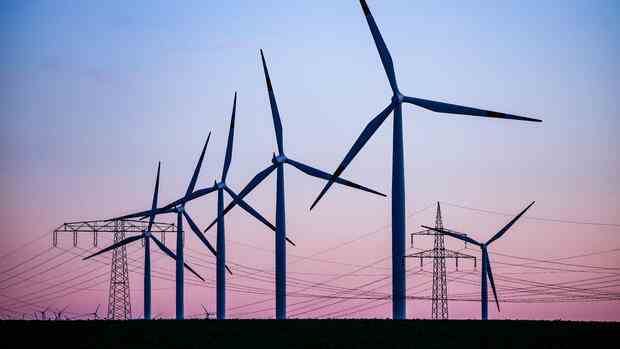The grid operators calculate that the expansion of the transmission grids is likely to cost many billions.
(Photo: dpa)
Berlin The operators of the electricity transmission grids assume that electricity consumption in Germany will double by 2045. In addition, the installed capacity of renewable energies is to increase by a factor of five to around 700 gigawatts (GW). This emerges from the first draft of the new network development plan (NEP), which the four transmission system operators in Germany presented on Friday.
According to their calculations, in order to integrate the additional electricity from renewable sources into the grid and to guarantee reliable grid operation, a massive expansion of the grids is necessary: ”The projects newly identified for the year 2045 cover a total of 14,197 kilometers of route lengths,” says one Notice from the network operator.
Of this, 5,742 kilometers were accounted for by onshore networks and 8,455 kilometers for the connection of offshore wind farms. A total of 128.3 billion euros would be needed for this, around 41.6 billion for the lines on land and 86.7 for the offshore network, the companies continue to write.
The transmission system operators in Germany are the companies 50Hertz, Amprion, Tennet and TransnetBW. They are obliged to submit a network development plan on a regular basis. This forms the basis for further network expansion.
The public consultation of the NEP draft begins today, Friday; Comments can be submitted until April 25th. They flow into the second NEP draft, which the transmission system operators hand over to the Federal Network Agency for examination. The NDP forms the basis for the further expansion of the network.
>> Read here: Network operator 50Hertz and Energinet are working more closely together in the Baltic Sea
The data in the draft NEP relate exclusively to the electricity transmission grids, i.e. the large “electricity highways” that transport electricity over long distances across the country. Irrespective of this, the distribution grids that bring the electricity to the factory and house connections at the local level must also be expanded. These upgrades are not part of the plan.
Energy transition can only succeed with grid expansion
The energy transition cannot succeed without grid expansion. Because the structure of power generation is changing with the rapid expansion of renewables, the grids have to be adapted accordingly.
Increasing amounts of electricity are being generated in northern Germany. This electricity has to be transported to the consumption centers in the south and west of the country, which requires additional lines. Bottlenecks in the electricity transmission network today mean that electricity generation from renewable sources has to be curtailed at times because the electricity cannot be transported away completely. In order to still be able to cover the electricity demand in the south, replacement power plants have to be used – a costly and inefficient process.
The wind farms in the North and Baltic Seas in particular will continue to grow in the future.
(Photo: Reuters)
In recent years, the electricity transmission system operators have already invested many billions of euros in the expansion of the networks. Despite intensive political efforts to push ahead with the network expansion, the expansion is lagging behind the original plans. The network operators appeal to create the conditions for a further acceleration of the network expansion.
In politics, they are being heard: “It is clear that we have to be much faster in the expansion of renewables as well as in networks and storage systems,” said Lukas Köhler, Vice President of the FDP parliamentary group, to the Handelsblatt. “Therefore, we should make the planning acceleration from the EU emergency regulation permanently possible,” recommended the FDP politician.
At the end of last year, the EU Council of Energy Ministers agreed on the emergency regulation, which should lead to a further shortening and simplification of approval procedures. However, it only applies to approval procedures that begin on June 30, 2024 at the latest.
Network operators take hydrogen development into account
The new network development plan defines the additional need for expansion, which is constantly growing with the ever more ambitious political goals. According to the transmission system operators, the plan assumes that a “comprehensive hydrogen infrastructure” will be available as early as 2037. “The NEP assumes that electrolysers will be built where they are useful for the grid,” says the transmission system operators – i.e. where it is ideal for the power grid.
Green hydrogen is produced by electrolysis using electricity from renewable sources. The transmission system operators advocate building electrolysers, especially in northern Germany, in order to use wind power there for hydrogen production. This reduces the need to expand the power grid.
Politically, however, this is not without controversy, because the south of Germany could be detached from the hydrogen supply. Although hydrogen can be transported, the transport is comparatively complex.
FDP politician Köhler warns that the choice of location for hydrogen electrolysis should be as open as possible. “The market regulates where ultimately hydrogen and where the direct use of electricity is more efficient,” he said. “It is also clear that we will continue to be dependent on energy imports. That is why an import strategy is an essential part of the hydrogen strategy,” he added. Energy self-sufficiency is “neither realistic nor desirable”.
More: A complete network infrastructure for hydrogen is to be created in the North Sea
